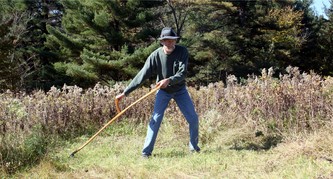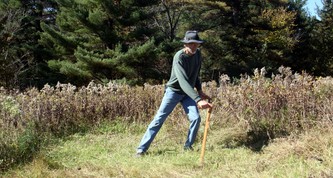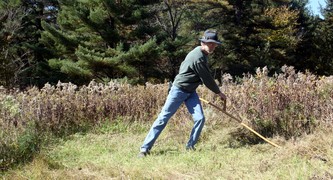I have created some virtual workshops to help you start out successfully with the European scythe. Before mowing, watch the next two videos to learn the technique:
Start slow and first get a feel for the cutting action of the blade. Most people instinctively swing a scythe like a hockey stick or golf club, and chop at the grass. They assume the curve of the blade is supposed to catch the grass stems and then the edge chops through them. Your scythe is NOT designed to be used like that! It's a precision mowing tool. Start by keeping the blade flat on the ground at all times, and slide it forward in an arc in front of you, in the direction that the tip is pointing. Start with short strokes, until you get a feel for the cutting action, (which is more of a shearing/slicing action.) There's no hacking or slashing involved. You only cut a narrow strip of grass with each stroke. The curve near the tip of the blade initiates the cutting action with a sliding cut (like when you start slicing a tomato). Then the rest of the curve of the blade escalates the initial sliding cut into a slicing cut. When you have a feel for this action, you can start to lengthen your stroke. Only mow as far as you can keep this shearing action going. Eventually, as you get the hang of it, you can lengthen your stroke to a full 180 degree arc in front of you. With practice and experience, your fine-tuned co-ordination will develop and you can then naturally start putting your weight into each stroke, for greater efficiency, as in the video below.
Field Mowing Technique
Below is a video that shows what mowing a prime hayfield with a scythe looks like from all angles, plus how long it takes to stop and hone the blade (not very long!).
I bThis morning, I got up at 5AM, because the grass was finally ready for a mow. After a few swings of the scythe, my mind cleared, I found my rhythm and I was "in the zone". Before I realized it, I had cut a quarter of an acre of grass and it looks like it was cut with my riding mower.
I stopped when the dew dried and peened my blade to a razor edge, so I can mow more tomorrow. I absolutely love my scythe and the low impact workout I get makes me feel great!
I found the Zen of using a scythe and I'm hooked on it. I plan to buy a second outfit in the near future, so my wife can join me in using this wonderful tool.
Thank you for being such an inspiration.
Gordon Trott.
Mowing on a Slope
I am often asked if scythes can mow on a slope. Yes they can! You will have to shorten your stroke some, but you can definitely mow a slope. You can mow going up the slope, you can mow going down the slope, and you can mow going across the slope, or you can mow at a diagonal. It depends on your situation, but the one thing you do not want to do is to mow across a steep slope with your blade mowing up the hill. It is much easier to mow with your blade sliding down the hill with each stroke as in the video below.
Trimming Techniques
Trimming along a fence
Trimming around young trees and other desirable plants. Here I am sparing a milkweed plant for the Monarch butterflies.
Light Bush Blade Technique
In the video below, I am getting some work done with the 50cm Fux light bush blade. Bush blade work is often a combination of quickly switching between more of a full stroke for when mowing easier weed stems and kurt trimming strokes for thicker woody stems.
In the video below, I am cleaning up an abandoned Ruth-Stout-method garden, overgrown by quack grass and Canadian thistles. I am using a 50cm Fux light bush blade with a 170cm Fux Snath. This area was well-fertilized with round bale hay and chicken manure wood shavings bedding, so the thistles grew quite large and tough. There is also some burdock growing in the corner, that I tackle as well. This all would have been much easier to scythe earlier in the season, while the thistles were small, but mowing them down just before flowering is supposed to set them back the most. We will see. They were about to flower, so I had to get them cut down quick. The stems were too big to use as mulch, so I created a compost stack with them. Deep hay mulch, smothers a lot of weed types, but not quackgrass, nor Canadian thistles. The round bales were full of thistle seed. Buying round bale hay can introduce a lot of weed seeds. Quack grass can ruin a Ruth Stout method garden.
Specialized Scythe Techniques
Chop and Drop
Cutting grass at a height above the ground
Grass is bendy and therefore much easier to cut with a scythe blade near the base of the plant, where it can bend away the least. With good technique and a sharp blade you can push the limits of how high above the base of the grass plant that you can mow. The more mature the grass is, and it is developing seed stalks, the easier it is to mow higher up. Grasses with stiffer stems, like timothy, brome, and foxtails, are the easiest to cut at a 6-inch height, which would simulate regenerative grazing. If you plan on cutting a lot of grass at a 6-inch height, I would suggest lowering the grips on your adjustable snath and using a light grass blade, to make it more comfortable on your arms.
Scything above the thatch
Another situation that you may want to mow at a height above the soil surface is, when there is a thick layer of thatch on the soil surface, and you do not want to get it mixed in with your fresh cut green grass. In the video below, I am using a super-sharp blade and mowing the grass about 3 inches above the soil surface. The soil here is sandy-loam and the grass is mostly quack grass with some brome mixed in. This area had not been mowed in years and the thatch was quite thick and substantial, but somewhat loose. I wanted to harvest the green grass for hay and mulch, but did not want to get the dead, musty, thatch grass mixed in with it. So I carefully mowed off just the green grass at about a 3 inch height.
Another technique you can use to mow a field with thick thatch is to add a wedge in between your tang of the blade and the snath, to raise your cutting edge, and tilt the balance of the blade, back towards it's spine. This will also raise the tip up and make it easier to slide the blade over the well flattened thatch, and cut just the green grass above. The area in this video had been left to grow all summer, the previous year, and then was mowed with a tractor in the fall, but the grass was left in place as mulch. The mulch was quite thick but was matted down by heavy wet snow during the winter. Adding a wedge made the blade slide over the thatch like a carpet, and just cut the upright green brome grass.


